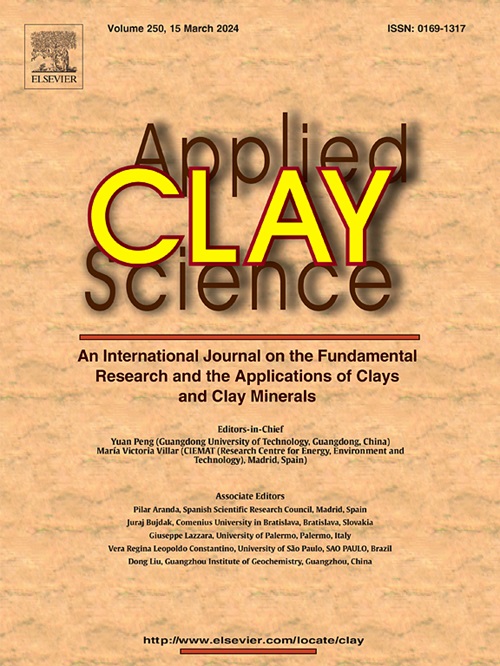The constraints on oxidation of structural Fe(II) by aqueous Fe3+ and the pathways of electron transfer in clay minerals
IF 5.8
2区 地球科学
Q2 CHEMISTRY, PHYSICAL
引用次数: 0
Abstract
Iron-bearing clay minerals act as crucial redox-active metastable phases in the fate of redox-sensitive constituents in aqueous environments. This study focuses on the constraints and pathways of electron transfer between structural Fe(II) (Fe(II)str) in clay mineral and aqueous Fe3+ (Fe(III)aq). Various batch experiments were conducted using partially reduced clay minerals to investigate the impacts of clay mineral type, reduction extent, initial Fe(III)aq concentration, and solution pH on the electron transfer process. The results demonstrate that higher reduction extents of clay minerals, higher initial Fe(III)aq concentrations, and lower pH conditions enhance the electron transfer. Notably, the existence of Fe(II)str is a prerequisite for its electron-donating to the Fe(III)aq, but the occurrence also depends on the availability of electron “bridges” such as Fe(II)-O-Fe(III) entities in the clay mineral lattice or the ability of Fe(III)aq to enter the interlayer space via ion-exchange. The pathway of Fe(II)str- Fe(III)aq electron transfer varies among different clay minerals: Fe(III)aq acquires electrons from Fe(II)str primarily through edge sites in nontronite, while through the basal plane in montmorillonite. In contrast, for the structurally stable illite without swelling properties, Fe(III)aq has difficulty in acquiring electrons from Fe(II)str. This study provides new insights into the geochemical cycling of iron in natural environments and its impact on redox-sensitive elements.
黏土矿物中Fe3+氧化结构Fe(II)的约束及电子转移途径
含铁粘土矿物在水环境中氧化还原敏感组分的命运中起着至关重要的氧化还原活性亚稳相的作用。本文研究了粘土矿物中结构铁(II) (Fe(II)str)与水中铁(3+)(Fe(III)aq)之间电子转移的约束和途径。采用部分还原黏土矿物进行了不同批次的实验,考察了黏土矿物类型、还原程度、初始Fe(III)aq浓度和溶液pH对电子传递过程的影响。结果表明,较高的粘土矿物还原程度、较高的初始Fe(III)aq浓度和较低的pH条件有利于电子转移。值得注意的是,Fe(II)str的存在是其电子给Fe(III)aq的先决条件,但其发生也取决于电子“桥”的可用性,如粘土矿物晶格中的Fe(II)-O-Fe(III)实体或Fe(III)aq通过离子交换进入层间空间的能力。不同粘土矿物之间Fe(II)str- Fe(III)aq电子转移的途径不同:Fe(III)aq主要通过非膨润土的边缘位置获得Fe(II)str电子,而在蒙脱土中则通过基面获得Fe(II)str电子。相比之下,对于结构稳定且没有膨胀特性的伊利石,Fe(III)aq很难从Fe(II)str中获得电子。该研究为铁在自然环境中的地球化学循环及其对氧化还原敏感元素的影响提供了新的见解。
本文章由计算机程序翻译,如有差异,请以英文原文为准。
求助全文
约1分钟内获得全文
求助全文
来源期刊

Applied Clay Science
地学-矿物学
CiteScore
10.30
自引率
10.70%
发文量
289
审稿时长
39 days
期刊介绍:
Applied Clay Science aims to be an international journal attracting high quality scientific papers on clays and clay minerals, including research papers, reviews, and technical notes. The journal covers typical subjects of Fundamental and Applied Clay Science such as:
• Synthesis and purification
• Structural, crystallographic and mineralogical properties of clays and clay minerals
• Thermal properties of clays and clay minerals
• Physico-chemical properties including i) surface and interface properties; ii) thermodynamic properties; iii) mechanical properties
• Interaction with water, with polar and apolar molecules
• Colloidal properties and rheology
• Adsorption, Intercalation, Ionic exchange
• Genesis and deposits of clay minerals
• Geology and geochemistry of clays
• Modification of clays and clay minerals properties by thermal and physical treatments
• Modification by chemical treatments with organic and inorganic molecules(organoclays, pillared clays)
• Modification by biological microorganisms. etc...
 求助内容:
求助内容: 应助结果提醒方式:
应助结果提醒方式:


